The foothills of the Apennines inland from Ancona produce Verdicchio, one of Italy's best known white wines. This tour meanders through vine-clothed valleys with the silhouettes of small medieval hill towns on every crest. The high peaks of the Apennines in the distance provide an ever-present backdrop.
The route starts at the polished city of Jesi and visits Cingoli, another lively town of distinction. For the rest of the journey, the road passes smaller places, each with its own distinct character - Ostra with its narrow alleyways; Apiro with its crumbling stuccoed centre and handsome views; Serra de' Conti with its striking old quarter.

I "mattoni" di Jesi
Along the way there are plenty of cantine, or wineries, where you can try the green-tinged Verdicchio wines. And at Morro d'Alba there is a stop to taste the town's unique red wine, Lacrima di Morro d'Alba.
The most memorable player along this route, however, is the landscape - homely rolling hills rising gradually towards the more stately peaks of the Apennines as we head south-west. For most of the way the tour follows winding backroads that follow the contours of the land with a low-geared, switchback approach to each small town.
The Route
Part I - Jesi to Apiro
The spruce city of Jesi - sometimes known as the "Milan of the Marche" for its vibrant character - warrants at least a day to explore. Its most striking feature greets you as you arrive - a belt of massive 14thC walls, built on Roman foundations, strengthened with buttresses and impregnable towers, and topped by houses. The main streets of the walled historic centre run along a long narrow ridge and there is much to tempt you to explore.
Start in Piazza Federico II which lies at the north-eastern end of the town where the Roman forum of Aesis once lay. The name of the square recalls the birth here of the fabled Medieval Hohenstaufen Emperor Frederick II in a tent on 26 December 1194 and known as Stupor Mundi for his stirring deeds.
A few steps down Via Pergolesi and you will be in Piazza Colocci and in front of Jesi's most handsome building, the Palazzo della Signoria. This text-book Renaissance palace was built at the end of the 15thC by Francesco di Giorgio Martini, the Sienese genius best known for his military architecture. Carry on along Via Pergolesi to Piazza della Repubblica; Jesi's largest square is dominated by the town's 18thC theatre, Teatro Pergolesi, home to a prestigious autumn opera season and named after the composer Pergolesi who was born here in 1710. From here, the long main Corso Matteotti runs straight as an arrow to end at an arch built in honour of Pope Clement XII in 1734. Stroll down the street in the early evening, seemingly with half the town's population, for a most civilised passeggiata, or communal stroll.
|
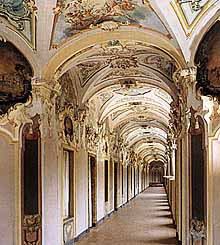
Pinacoteca - Jesi
|
|
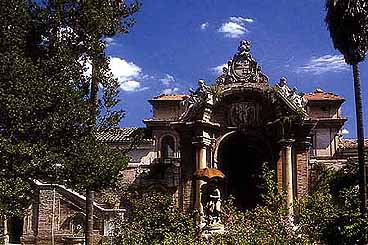
Palazzo Pianetti - Jesi
|
On parallel Via XV Settembre stands Jesi's most flamboyant building, Palazzo Pianetti. Look inside to see the sugar-candy stucco work in the long galleria. This over-blown decoration alone would merit a visit; but the added bonus of the civic art gallery (Pinacoteca Comunale) makes it obligatory - here you’ll find a small group of some of Lorenzo Lotto's finest works - The Judgement of Santa Lucia, a Visitation, an Annunciation and a restless Deposition.
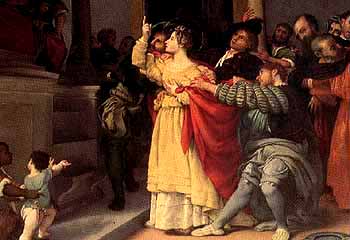
The Judgment of Santa Lucia - Lorenzo Lotto - Pinacoteca di Jesi
Follow the main road out of Jesi signposted Roma (yes, all roads in central Italy do seem to lead to Rome). Then turn off south for Cingoli.
The route now leaves the busy valley of the Esino as it climbs towards our first stop at Staffolo. The last stretch of the approach to this sturdy fortified medieval town boasts fine views - olive groves and vineyards spread out below the town walls. Large stretches of the intact walls now have houses built on top - a miniature version of the great walls of Jesi. During the second week of August the town gives itself over to the Festa del Verdicchio, a colourful festival dedicated to the local incarnation of Bacchus.
From here we now backtrack a short distance to the road for Cingoli and a splendid climb up to the "Balcony of the Marche". This ancient high place has plenty of treasures to explore. The place has earned its nickname for its sweeping panoramas - the best views are from behind the church of San Francesco. Climb up Corso Garibaldi to Piazza Vittorio Emanuele, once the forum of Roman Cingulum and still the heart of this stone-built town.
To one side stands a fine 16thC Renaissance town hall with a much earlier clock tower. Inside is the town's Pinacoteca, or art gallery, with another of the Marche's serendipity paintings by Lorenzo Lotto, this time a sumptuous Madonna of the Rosary. Cingoli's brief moment of glory came with the one-year papacy of its son, Pius VIII, in 1829 - it was he who ordered a new facade for the late Baroque Cathedral on the main piazza, never finished due to his early death. Behind the town hall is the stern Via del Podesta', Cingoli's most atmospheric street.
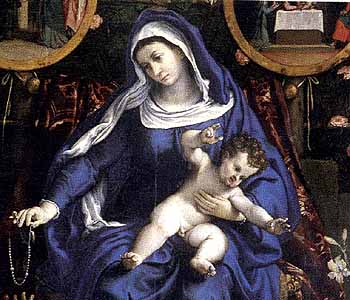
Madonna del Rosario - Lorenzo Lotto - Pinacoteca di Cingoli
Again a short way back in our tracks to take the roller-coaster road for the hill village of Apiro. This handsome place 500 metres up has a splendid backdrop of the solitary peak of Monte San Vicino and an honest old centre with a fine tower and pretty church in its tight main square.
Part II - Apiro to Montecarotto
From Apiro the tour heads for the gentler hills around Cupramontana. Alternatively you might like to wind through country lanes and join the main SS256 to make a detour down south to the wine town of Matelica. Most of the life of this airy place revolves around the central Piazza Mattei, with its elegant seventeenth century fountain. Around it you'll find the town's chief attractions - the Loggia of the Ottoni family, built by the town's ruling family in 1511 and the 13th century Palazzo Pretorio, topped by an 18th century tower. In one of the side-chapels of the church of the Suffragio, search out Salvator Rosa's tortured painting of the Crucifixion and souls in purgatory. Also worthy of note are the cathedral, with its 15th century bell tower, in Corso Vittorio Emanuele, and the church of the Maddalena, with its Romanesque portal and facade. Before you leave, be sure to buy a couple of bottles of the town's own Verdicchio, Verdicchio di Matelica, some of the best you'll taste.
Back on course, our route makes for the agricultural market town of Cupramontana. Standing in a typical gently-rolling Marche landscape amidst Verdicchio vineyards, this is one of the most important centres for wine production and a good place to stock up with a few more bottles.
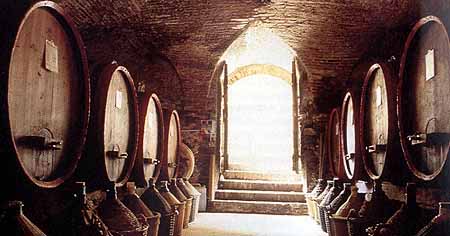
Una cantina di Cupramontana
Heading back down to the more developed Esino valley, make a brief pause at Maiolati Spontini. This tiny place was where the composer Gaspare Spontini (1774-1851) was born. He is buried in the church of San Giovanni, under an august neo-classical monument carved by the great Canova. The small Spontini museum, opposite the church in the house where he died, contains a collection of his manuscripts and possessions. The village also boasts balcony views over the valley below.
The tour now dips down to the valley, briefly joins the main road then quickly turns off to return to more beguiling countryside as we head for Montecarotto. For a change, the heart of this compact little borgo is at the bottom of the hill in Piazza della Vittoria. Here two fairytale towers, all that is left of a medieval castle, greet you as you drive in.
Part III - Montecarotto to Jesi
Following a particularly memorable stretch of country road, the tour winds down the creases of a valley with fine views as we head for Serra de’ Conti. The first sight of its old centre is striking - high walls with elegant lofty palazzi and a strong architectural unity. Pause awhile to wander the hidden corners of this elegant small place. Its heart lies in Piazza Leopardi with a fine octagonal tower.
From Serra de' Conti the route follows tight curves to join the main SS360 road in the Misa valley. Follow the signs for Senigallia and speed towards the turn off for Ostra. This imposing walled town is strung out along a ridge overlooking the valley. Its old centre, topped by the noble Torre Civica and Piazza dei Martiri, its red-brick main square, has plenty of attractive details to amuse the eye. Look out for the prosperous looking 18th century palazzi along the main Corso Mazzini.
Splendid views again accompany you as the tour heads south for a brief pause at Belvedere Ostrense, a sober small town with sturdy walls and airy panoramas.
Then on to Morro D’Alba with occasional glimpses of the Adriatic Sea only 10 km away.
The pleasing old part of this rocky village is embraced by an escarpment wall dating back to the second half of the15th century. Atop these walls runs a remarkable walkway pierced by porticoes that offers ever-changing views of the delightful countryside around. There is another excellent reason to stop here - to try its celebrated local red wine, Lacrima di Morro d'Alba. A heady garnet brew with an elegant finish, definitely a cut above a mere country wine.
From Morro d'Alba you can either head straight back to Jesi or take a slightly longer route via Chiaravalle. This busy town has one good reason for you to stop - to see the Abbey of Santa Maria in Castagnola, often known simply as the Abbey of Chiaravalle. Founded in 1126, it is one of only three monasteries founded in Italy by the Cistercian monks of Clairvaux from France. An outstanding and rare example of ecclesiastical Gothic architecture in the region, it has a singularly striking facade.
Routes
Tour 1 - The Castles of Montefeltro
Tour 2 - From Paper to Stone
Tour 3 - The Vineyards of Verdicchio
Tour 4 - The Heartland of Le Marche
Tour 5 - In the Shadow of Monte Conero
Tour 6 - The Wild Mountains of the Sybil
Tour 7 - In the Footsteps of Ancient Rome
Tour 8 - Ascoli's Hidden Heritage
Tour 9 - Beside the Seaside
© Liberation Ventures Ltd.